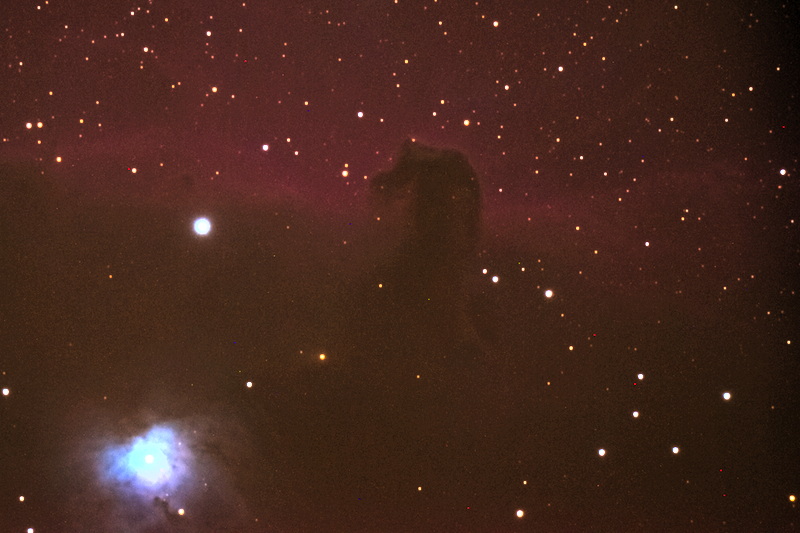
D7000 DSLR Imaging: NGC488 Galaxy, Horsehead Nebula
Posted: 10 December 2012
Cloudy skies returned on Saturday, 8 December 2012, as seen in this sunset image from my "Live Webcam":

The sky cleared again on Sunday, 9 December, and the observatory was opened at 2142 MST, 46°F. At 2148 MST, viewed Jupiter at 77X and 222X. There was a strong breeze blowing and seeing was not very good, but I wanted to try some DSO imaging anyway. My first target was NGC488, a small faint galaxy. Mounted the D7000 DSLR at prime focus of the 8" LX200-ACF. Did a focus test with the Bahtinov Mask at 2210 MST using the star Alpha Pisces. Locked the telescope focus. I then slewed to NGC488 and began looking for a guide star. I initially tried to use a very faint one, visible in the illuminated reticle eyepiece only with averted vision. But the seeing wasn't good enough to maintain sight on the star so I looked for and found a better guide star. This is a slightly cropped, guided 5 minute, ISO 6400, exposure:

My next DSO target was the Horsehead Nebula. I have imaged it in the past but I wanted to take several exposures and stack them using Keith's Image Stacker. I did a couple of framing test exposures and located an excellent guide star. The wind had gotten stronger and seeing was poor, making accurate guiding a challenge. I was able to capture six 5 minute, ISO 6400, exposures. This first image is the first one I captured this night and is unedited (but slightly cropped). Left of the Horsehead is a tumbling satellite moving vertically. NGC2023 is the nebula at the lower left.

This is a stack of the six 5 minute exposures, yielding an effective exposure of 30 minutes at ISO 6400:

I ended the imaging at 2317 MST. Due to the wind and poor seeing I decided to end the session. I took a quick look at M42, the Great Nebula in Orion, 77X, prior to closing up for the night.
Closed the observatory at 2333 MST, 41°F.
I have to say a word about Sir Patrick Moore, who died on Sunday, 9 December 2012. His more than a half-century impact on astronomy, especially amateur astronomy, will continue to be felt long after his death. Although I never met him, he had a direct impact on me. Over a decade ago, I was asked to write a book about the Meade ETX telescope. It would be published by Springer in their "Patrick Moore's Practical Astronomy Series". After I submitted a draft outline and a sample chapter, I received an email from my editor at Springer saying that Patrick Moore had approved the book based on my outline and sample chapter. I was honored and humbled that this icon of amateur astronomy would approve of something I did. The book "Using the Meade ETX" was published in 2001. Friends and colleagues of Sir Patrick Moore have established a Sir Patrick Moore Memorial Website.
Comments are welcome; use the Comments section below, or you can Email Me. Thanks.
Go to the previous report.
Return to the Cassiopeia Observatory Home Page.